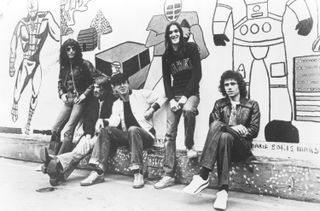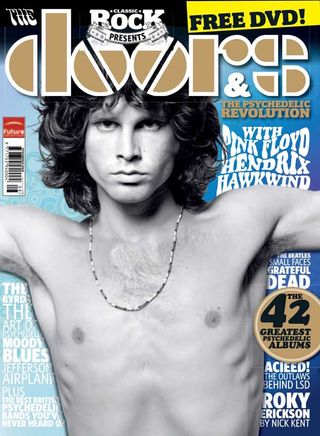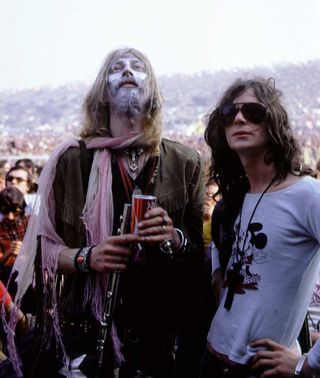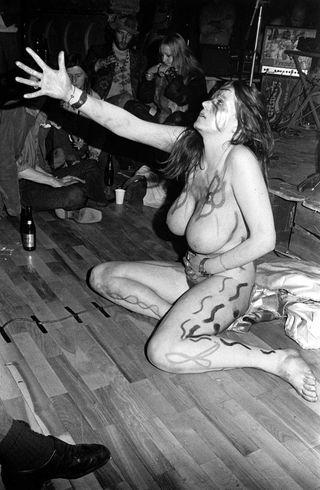Hawkwind began out with one clear musical intention: to create the sights, sounds and sensations of an acid journey, in order that the viewers may share the expertise with out the assistance of any medication. In 2008, the band’s official biographer Carol Clerk appeared again on the early days of a profitable mission.
Hawkwind weren’t shy of indulging in LSD. Quite the opposite, a lot of the band members had been taking a great deal of it, and those that weren’t shortly left.
After one surprising hallucinogenic journey, unique bass participant John Harrison disappeared off the face of the Earth, or at the very least to America, by no means to be seen once more. He has nonetheless to gather the tens of hundreds of kilos in royalties which were gathering curiosity for him in a particular checking account for the final 38 years [Harrison died in 2012].
Guitarist Huw Lloyd-Langton’s expertise of being spiked was much more dramatic. He grew to become engulfed by all of the horrors of a horrible journey on stage on the 1970 Isle Of Wight Competition, and subsequently suffered an entire nervous breakdown. Not like Harrison, nonetheless, Huw can be courageous sufficient to return to the mothership some years later.
The story of Hawkwind started with Dave Brock (vocals and guitar) and Mick Slattery (lead guitar). Dave and Mick had been busking companions within the mid-60s, happening to type quite a few casual teams that performed in blues and people golf equipment round London. In 1967, each had been exhilarated by the brand new psychedelia. With Brock recruiting Slattery to the second incarnation of his band
The Well-known Treatment, they set off on a tour of Holland with Tent 67, a psychedelic rock circus that travelled from city to city with an enormous tent. The Well-known Treatment performed prolonged blues jams with as many unusual results as Dave and Mick may coax out of their guitars. Returning to London, they hoped to arrange a band that may discover psychedelia by fusing lengthy improvisations with digital music.
This was not virgin territory for both participant. Brock had discovered to make tape loops throughout a quick interval of employment as an assistant movie editor at a studio producing cartoons and TV advertisements. He went on to spend hours in his Putney flat, making bizarre sounds together with his guitar, an echo unit and a tape machine.
“There was loads of bands doing bizarre stuff,” says Brock. “I used to fiddle round with tape loops. Mick Slattery used to return spherical to Putney and we used to plonk round there.”
On the identical time, Brock was conscious that psychedelia wasn’t simply in regards to the music: it was a few multi-sensory expertise and, within the wider context, about another way of life.
He remembers: “I used to go all the way down to Center Earth, the UFO and these golf equipment within the 60s, and we used to take LSD and soar round carrying our brightly colored garments. Individuals may dance round like gazelles in the event that they wished to. It was freedom of expression. You’d go into Center Earth and it might scent of incense and it might have smoke machines and lights flashing. It created an surroundings. That’s what individuals wished then, these fantastic environments the place you may soar round and bands would play lengthy items of music. The Arts Lab had arty movies and the outdated mild exhibits with blobs flashing up on the display screen. These had been the beginnings of psychedelia in England.
“Our vibrant garments had been towards the standard nine-to-five of greyness and drabness and fits and bowler hats. Sporting vibrant colors, letting your hair develop lengthy, was to be completely totally different – the psychedelic revolution! There was this glorious, magical free spirit. Individuals had been making an attempt to say: ‘We need to change issues right here.’”

The music was the soundtrack to a counterculture that embraced all types of artistic people, together with poets, artists, writers, garments and lighting designers, photographers, silk-screen printers and market merchants. Information was exchanged, gigs marketed and crusades mounted by means of the pages of the underground press. Publications equivalent to IT and Frendz would lambast drug squads and censorship whereas boldly campaigning for feminism, homosexual liberation, animal rights, CND, environmental consciousness and the legalisation of hashish.
“Notting Hill Gate was an actual hotbed of revolution,” says Brock. “We’d cling on the market and meet all these individuals. It was fairly a close-knit circle. A neighborhood.”
Nonetheless, it was not in Notting Hill’s hippie enclaves of Portobello Street and Ladbroke Grove, however within the Tottenham Courtroom Street subway the place Hawkwind started. Brock was busking when he struck up a dialog with bass participant John Harrison, ex of the Joe Loss Band, and shortly snapped him up for the brand new group. Drummer Terry Ollis, who’d beforehand solely performed informally with mates, was recruited by means of a labeled advert in Melody Maker.
Brock, Slattery, Harrison and Ollis instantly started rehearsing in earnest. The classes consisted of “lengthy solos with echoes and repetitive rhythm patterns”, in accordance with Brock.
Sometimes, their two roadies would take part for a jam. One was Dik Mik, an outdated pal of Brock and Slattery, who’d drummed in an early line-up of The Yardbirds. Now he had moved from the drumstool and was creating extraordinary sound results utilizing an audio generator and an echo unit.
“He wasn’t randomly making plenty of noises,” says Dave. “He used to attempt to play the notes that we’d be enjoying.”

Dik Mik’s buddy and fellow roadie was Nik Turner, an itinerant musician steeped in conventional and avant-garde jazz. Turner, a roustabout on the Tent 67 tour of Holland, contributed by blowing chaotic, free-form saxophone.
“Nik couldn’t play it correctly,” provides Brock. “However he had his echo unit, you’d get all these notes flying round and it was actually quick, so it labored with what we had been doing.”
Turner and Dik Mik added new and thrilling dimensions to the sound, and it wasn’t lengthy earlier than the roadies joined the band. They made their first look, as a six-piece known as Group X, at All Saints Corridor, Notting Hill, in August 1969.
It wasn’t a lot a gig as a wild and cacophonous 15-minute jam, but it surely was sufficient to safe the moment approval of DJ John Peel – and a administration deal. A report contract with Liberty shortly adopted, by which period Group X had briefly turn into Hawkwind Zoo after which lastly, simply Hawkwind.
Extremely, simply when all the things was coming collectively so completely, Mick Slattery walked out, primarily as a result of he fancied a visit to Morocco.
As soon as once more destiny lent a serving to hand within the Tottenham Courtroom Street subway, the place Dave Brock occurred to stumble upon the proficient younger guitarist Huw Lloyd-Langton. Huw had beforehand labored in a West Finish music store, and had met Dave there. Now he was at a free finish, after a 12 months touring European military bases as a backing musician, and was solely too happy to just accept Brock’s provide of a jam. It was, actually, an audition for Hawkwind. Lloyd-Langton handed the take a look at with flying colors and joined the band.
“Initially, the aim of the train was to create a scenario that may be a visit in itself with out partaking of any substances, with lights and psychedelic sounds,” explains Huw.
“The concept was for individuals to get spaced out,” provides Brock. “The sound frequencies – high-frequency sound and low rumbles – have an effect on your physique and, actually, your mind. So with out taking medication, you’d turn into disorientated and also you’d turn into concerned within the mild present and the entire expertise.”
The end result was very efficient. On one memorable event this maybe labored too effectively, as Dave fondly remembers. “We performed some college, I can’t keep in mind which one, the place everyone within the viewers acquired pissed and lots of people had been actually sick. You’ve been ingesting beer and also you’ve acquired a large strobe flashing on and off and bizarre sounds happening – that’s going to make you ailing. We acquired banned from that college.”
In these early, impoverished days of Hawkwind, a strobe was all they may afford in the way in which of lights, but it surely actually made its presence felt, and never simply on the spectators.
“I do recall the strobe bashing my flipping brains in,” admits Huw.
“We simply switched it on and it used to make all our gear go, ‘click on, click on, click on’,” chuckles Brock. “Once we had been enjoying a quick quantity, you had been capable of hear all this gradual clicking happening.”
Hawkwind gigged relentlessly, sleeping of their outdated van until a college students’ union they performed at was type sufficient to supply to place them up on campus. The van – dubbed ‘The Yellow Wart’ – was already getting used as a handy crash pad in London by varied members of the band who discovered themselves with out someplace to put their heads. This didn’t often embody Nik Turner, nonetheless, as though he was homeless, he had found out a sophisticated itinerary of squats and flats the place he was welcome to doss down on the ground.
“The van was an entire tip… terrible-smelling socks,” says Lloyd-Langton, bluntly.
“Behind the seats was sufficient room for a number of individuals to put subsequent to one another of their sleeping baggage, just like the seven dwarves,” elaborates Brock. “Sometimes Dik Mik would sleep on prime of the gear, solely about two toes away from the highest of the roof.
“We additionally used to do fairly just a few gigs on flat-back lorries in Notting Hill Gate and Wormwood Scrubs Frequent, and in 1970 on the Bathtub Competition with The Pink Fairies. All our gear acquired lined in mud and the guitars went out of tune with the generator going up and down. None of this stuff had been romantic. It was fairly a tough outdated way of life. However we had been working quite a bit.”
Hawkwind went across the size and breadth of Britain, enjoying in each pupil corridor and small venue that may have them. However in line with the spirit of the age, in addition they carried out an unlimited variety of free concert events and profit gigs for the causes espoused by the counterculture, distributing flyers and copies of other newspapers to their audiences.
“I don’t recall ever being paid in these days, however I didn’t care,” remembers Huw. “All I used to be involved about was getting up and enjoying for the love of it. Simply as long as we had sufficient petrol to get to the subsequent gig…” And naturally, there was all the time LSD.
“All of us used to take acid collectively,” asserts Brock. “It was a superb drug to take, inside purpose. It made you query issues a bit extra. It’s helped so many artists, writers and musicians by supposedly ‘opening the doorways of notion’. Yeah, it does make some individuals go haywire, however you must be in the proper temper to really get pleasure from it. And you must be sure you have any individual there to regulate issues in case you could have a nasty journey.
“It’s all to do with the chemical state of the physique and your state of mind. Later, there was plenty of unhealthy acid spiked up with rat poison and pace, however within the early days, when it was very pure, it was okay.”
LSD was actually within the combine when Hawkwind recorded their debut, self-titled album at Trident studios in spring 1970. Produced by The Fairly Issues’ guitarist Dick Taylor it was, says Huw, “a occurring”.
He provides: “Someday we took a hallucinogenic substance, and we couldn’t play a specific quantity as a result of we couldn’t cease laughing about one thing – I don’t know what it was. The engineer was a really straight, be-suited, bespectacled man, and he thought it might be an excellent concept to report us having a cackle and do one thing with it on the album, however as quickly as he acquired the mics out, the laughter simply stopped. He ended up doing cartwheels and all kinds of stuff to attempt o get everyone to snigger once more. The poor bloke was so annoyed.”
The album consists of fabric that Hawkwind had been enjoying for months. Recorded reside with only a few ending touches added later, it captures precisely how the band sounded in 1970, specializing in lengthy, experimental, blues-based work-outs delivered with a riot of mad digital results and spontaneous, honking sax.
“It undoubtedly painted an image of that Notting Hill hippie circumstance higher than something the outdated Pink Floyd had accomplished,” asserts Huw. “I don’t care what anyone says.” Brock agrees: “I’d name {that a} psychedelic album all proper.”
However by now, issues had been turning into troublesome for John Harrison, who a lot most well-liked a quiet spherical of golf to an acid-fuelled rave. And his issues actually got here to a head in the summertime when Hawkwind retreated to a Cornish cottage for rehearsals. “I actually appreciated John,” begins Dave. “He was the anchor man, a very good bass participant.”
However… “He wasn’t into taking as many medication as us. We had been all a bit excessive in our drug-taking – LSD, natural mescaline, and we actually used to smoke our marijuana. We did truly spike individuals up, however we stopped doing that after some time. Engineers wouldn’t drink something as a result of they had been as paranoid as will be that we’d spike them up.”
Harrison was clever to his bandmates’ tips in Cornwall: “No, no, I don’t need any medication. No, I don’t need a cup of tea.” However ultimately somebody managed to slide some mescaline into Harrison’s glass of milk.
“We may see him enjoying golf on the moors, whacking the balls and working after them,” says Brock. “He actually had a beautiful time.”
Not fantastic sufficient, although. And he refused to alter his thoughts about his dislike for hallucinogenics.
“I believe he acquired a bit fed up with our over-the-top behaviour and left,” continues Dave. “Additionally, he used to get pissed off when issues would simply dissolve right into a state of anarchy on stage. The place numbers would go on endlessly, with Dik Mik making noises. John simply vanished, actually.”

His alternative was Thomas Crimble, a bassist from the Notting Hill neighborhood, who took over in time for Hawkwind’s residency on the legendary five-day Isle Of Wight Competition. However the occasion shortly grew to become a calamitous mess when nearly half one million individuals turned up with out tickets and demanded to be let in without spending a dime.
Hawkwind weren’t on the official pageant invoice, however they turned as much as play a collection of free gigs outdoors the perimeter, most of them in an inflatable dome known as Canvas Metropolis. It was simply earlier than one in all these gigs that Huw Lloyd-Langton took an enormous swig of apple juice, solely discovering afterwards that it had been closely dosed with LSD.
He remembers: “I’d taken a tab of acid some months earlier than, and I ‘died’ on that journey and went to not a really good place. Because of this, I’d determined to not contact the substance once more.”
Initially he tried to soldier on with the gig. “I don’t know what number of journeys had been on this apple juice. I didn’t need to ‘die’ once more. Dik Mik, our expensive outdated knob-twiddler, stated: ‘If you happen to struggle it, all the things turns adverse. Simply go along with it. Let it stream.’ The guitar was caught in my hand and I used to be instructed I needed to do a gig. I began hallucinating at that time.
“I used to be led to the stage. It was absolute psychedelia, plenty of gory flashing lights and folks freak-dancing. So far as I used to be involved, I’d simply descended into hell. I used to be standing on a type of padded mattress that was there to cease the dew stepping into the electrical energy. Sadly for everyone, it was me that tuned the band up.
“I had my tuning fork and I acquired the notice, however the notice did what the mattress below my toes was doing, going up and down. So there was no method on earth I may tune my very own guitar up, by no means thoughts tune everyone else up, and likewise, in the meantime, I used to be in hell, damned to be enjoying there for eternity.
“Finally I simply whacked a chord out and this cacophony began up. It should’ve been atrocious. About midway by means of the gig, I truly acquired down on my knees and prayed that God would forgive me and launch me from this example. Lastly we acquired out of the blooming place and I walked all the way down to the ocean and I baptised myself.
“Later Nik stated: ‘ on the stage if you acquired in your knees and prayed? That appeared actually good. Maintain it within the set.’ What he didn’t realise was that I meant it. Solely myself and God know what I used to be going by means of.
“I used to be nonetheless recovering from the journey the subsequent evening after I did a gig on this tent with Thomas Crimble. We performed proper by means of the evening, from nightfall until daybreak. Afterwards, I felt vaguely cleansed. I don’t keep in mind ever getting a greater guitar sound; it was marvellous. This bunch of Brazilian percussionists had been there, and so they clicked in. Two or three individuals steered that Hendrix got here into the tent and sat there, and I used to be up there enjoying the shit out of my mind. One individual stated he steered to Hendrix that he acquired up and performed, and he apparently stated, ‘No, I’d spoil it.’”
Hendrix additionally seen an extravagantly made-up Nik Turner on the pageant, dedicating a tune to “the man with the silver face”. Images of Turner later appeared in a number of nationwide and worldwide magazines, giving Hawkwind their first mainstream press protection. As an extra profit, they gained nice kudos for taking a stand without spending a dime pageant music, a coverage they might champion for years to return. Their bookings – and their following – expanded accordingly, and so they appeared in live performance with all the main psychedelic bands of the period.

The hippie dream was dying in America, following Altamont and the Manson murders, however in England in 1970, the freak scene was alive and effectively and as idealistic as ever. Nonetheless, Hawkwind had been shifting into their thrilling future with out Lloyd-Langton, who handed in his discover, nonetheless reeling from the aftershocks of the acid expertise. In truth, he was heading for a breakdown, which began abruptly one evening in entrance of the TV.
“Frankie Howerd was on,” he remembers. “I had a few puffs of this very sturdy dope and my eyes began flicking between the crap I used to be watching and this excellent, pure white flower that was on prime of the telly – the nice and the evil. The one method I can probably describe it was that I felt my soul dying. I used to be frightened out of my flipping circumstance. I put that joint down and I didn’t contact any substance once more for at the very least 10 years. Even now, I’ll solely have a puff very sometimes, simply to be sociable.”
Huw was out of motion for fairly some time as he wrestled together with his sanity. He would return to Hawkwind 9 years later after stints with fashionable touring acts together with Widowmaker and Leo Sayer. For now, although, Dave Brock took care of all of the guitar enjoying.
There have been a number of different comings and goings within the Hawkwind ranks over the subsequent variety of months. After Christmas that 12 months, Thomas Crimble left for what can be a 30-year profession with Michael Eavis on the Glastonbury Competition organisation, making method for the subsequent bassist, Dave Anderson – an English participant previously belonging to Amon Düül II.
Hawkwind additionally acquired an enormous new attraction – the large breasts of Amazonian dancer Stacia, who usually stripped on stage to disclose a totally bare physique painted with flowers and different vibrant illustrations. Having first met Nik Turner on the Isle Of Wight Competition, Stacia turned as much as see the band at Redruth, Cornwall, in April 1971, requested to bounce with them, did, and was instantly invited to affix the line-up.
“Free expression was the item,” says Dave Brock, explaining Stacia’s eagerness to disrobe. “Individuals used to say: ‘I need to take all my garments off and be free and soar round.’ That’s what she did. That was the entire thing with LSD – artwork, music and folks taking their garments off. Terry Ollis used to do the identical factor as a result of he used to sweat quite a bit behind the drumkit, so he took off all his garments. It was that freedom.”
Del Dettmar, recruited at across the identical time, was nonetheless dedicated to preserving his garments on. Dettmar, Hawkwind’s gnome-like street supervisor, was promoted into the band for his synth and keyboards wizardry, and the formidable digital partnership he cast with Dik Mik grew to become a staple of the band’s sound – and likewise influenced later generations of dance musicians.
On the identical time, Hawkwind had been gathering a crack crew of collaborators from amongst their artistic cronies in Notting Hill: poet Robert Calvert (an outdated buddy of Nik Turner’s); Michael Moorcock, the prolific science-fantasy author; Barney Bubbles, the gifted designer; photographer Phil Franks; onstage DJ Andy Dunkley; and lighting designer Jon Smeeton, aka Liquid Len, who masterminded sensational mild exhibits, serving to Hawkwind progress from one large strobe to layers of spinning display screen projections.
With the help of this wonderful crew, Hawkwind had been shifting in direction of the all-encompassing musical and visible id they’d all the time dreamed of. However there was a shift in emphasis. Nik Turner as soon as put it like this: “Initially, the factor was very way more internal area, not outer area. It was mind-expanding.”
With their subsequent album, In Search Of Area, a High 20 hit, Hawkwind would turn into pioneers and lifelong explorers of area rock.
And Lemmy wasn’t a lot as a twinkle in anyone’s eye. But.
This characteristic initially appeared in Basic Rock Presents: The Doorways & The Psychedelic Revolution (August 2008). The deluxe model of Hawkwind’s In Search Of Area is out now.

